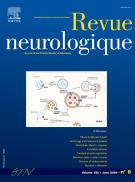Care pathways and healthcare use of stroke survivors six months after admission to an acute-care hospital in France in 2012 - 20/05/16
 , S. Samson a, A. Fagot-Campagna a, F. Woimant b
, S. Samson a, A. Fagot-Campagna a, F. Woimant b| pages | 12 |
| Iconographies | 0 |
| Vidéos | 0 |
| Autres | 0 |
Abstract |
Introduction |
Care pathways and healthcare management are not well described for patients hospitalized for stroke.
Methods |
Among the 51 million beneficiaries of the French national health insurance general scheme (77% of the French population), patients hospitalized for a first stroke in 2012 and still alive six months after discharge were included using data from the national health insurance information system (Sniiram). Patient characteristics were described by discharge destination–home or rehabilitation center (for < 3 months)–and were followed during their first three months back home.
Results |
A total of 61,055 patients had a first admission to a public or private hospital for stroke (mean age; 72 years, 52% female), 13% died during their stay and 37% were admitted to a stroke management unit. Overall, 40,981 patients were still alive at six months: 33% of them were admitted to a rehabilitation center (mean age: 73 years) and 54% were discharged directly to their home (mean age 67 years). For each group, 45 and 62% had been previously admitted to a stroke unit. Patients discharged to rehabilitation centers had more often comorbidities, 39% were highly physically dependent and 44% were managed in specialized neurology centers. For patients with a cerebral infarction who were directly discharged to their home 76% received at least one antihypertensive drug, 96% an antithrombotic drug and 76% a lipid-lowering drug during the following month. For those with a cerebral hemorrhage, these frequencies were respectively 46, 33 and 28%. For those admitted to a rehabilitation center, more than half had at least one visit with a physiotherapist or a nurse, 15% a speech therapist, 10% a neurologist or a cardiologist and 15% a psychiatrist during the following three months back home (average numbers of visits for those with at least one visit: 23 for physiotherapists and 100 for nurses). Patients who returned directly back home had fewer physiotherapist (30%) or nurse (47%) visits but more medical consultations. The 3-month re-hospitalization rate for patients who were discharged directly to their home was 23% for those who had been admitted to a stroke unit and 25% for the others. In rehabilitation centers, this rate was 10% for patients who stayed < 3 months.
Conclusions |
These results illustrate the value of administrative databases to study stroke management, care pathways and ambulatory care. These data should be used to improve care pathways, organization, discharge planning and treatments.
Le texte complet de cet article est disponible en PDF.Keywords : Stroke, Hospitalisation, Rehabilitation, Treatments, Healthcare use, Re-hospitalization, Follow-up
Plan
Vol 172 - N° 4-5
P. 295-306 - avril 2016 Retour au numéroBienvenue sur EM-consulte, la référence des professionnels de santé.
L’accès au texte intégral de cet article nécessite un abonnement.
Bienvenue sur EM-consulte, la référence des professionnels de santé.
L’achat d’article à l’unité est indisponible à l’heure actuelle.
Déjà abonné à cette revue ?

